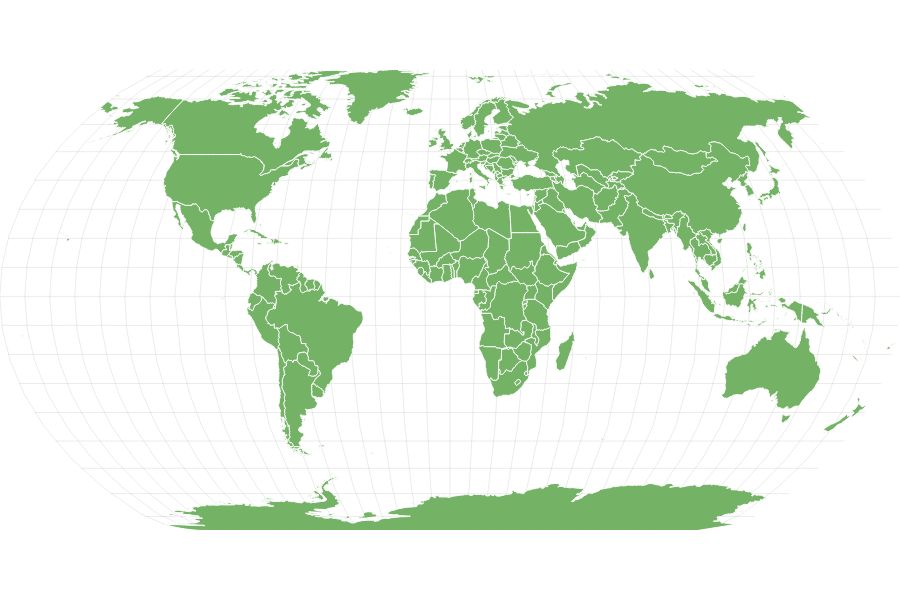Stingray
They transfer venom into the predator’s body through spines in their tail.
Advertisement
Stingray Scientific Classification
Read our Complete Guide to Classification of Animals.
Stingray Conservation Status
Stingray Facts
- Prey
- Snails, clams, and squids
- Group Behavior
- Solitary
- Fun Fact
- They transfer venom into the predator’s body through spines in their tail.
- Estimated Population Size
- Not known
- Biggest Threat
- Sea lions, seals, sharks, and other large fish
- Distinctive Feature
- Flattened body shape and venom filled tail
- Gestation Period
- Three months
- Habitat
- Black and Mediterranean Seas
- Predators
- Sea lions, seals, sharks, and other large fish
- Diet
- Carnivore
- Average Litter Size
- 8
- Lifestyle
- Solitary
- Favorite Food
- Snails, clams, and squid
- Type
- Fish
- Common Name
- Stingray
- Number Of Species
- 200
- Slogan
- It's stinger is razor-sharp or serrated!
View all of the Stingray images!

Stingrays are very easily recognizable and have pancake-like bodies.
Stingrays are fish able to glide gracefully through the water. There are about 200 different species in the oceans around the world. They also live in lakes and freshwater rivers. Categorized as a group of sea rays, they are related to sharks.
They consist of eight families of fish: Plesiobatidae, Urotrygonidae, Hexatrygonidae, Urolophidae, Potamotrygonidae, Dasyatidae, Myliobatidae, and Gymnuridae. However, stingrays all around the world face threats to survival. Rather than bones, their bodies consist of cartilage.
These fish also have camouflaging capabilities that allow them to escape their predators.
They are known to hit predators with their tails upon sensing danger, which is particularly effective as a result of a barb on their tail.
An Incredible Fish: Five Stingray Facts!
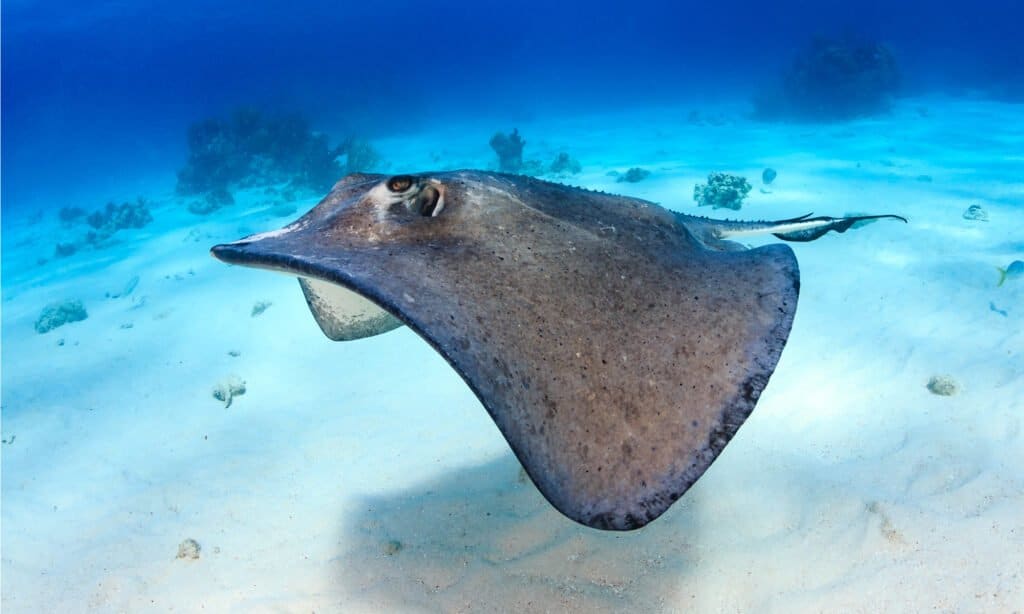
These fish have flat bodies that help them camouflage and blend with their surroundings.
©Richard Whitcombe/Shutterstock.com
- Related to sharks: As part of a group of fish called batoids, stingrays aren’t that different from sharks. Though there are clear differences in size, shape, and anatomy, both animals have cartilage (rather than bone). This similarity has given them the nickname “flat sharks.”
- Flat-bodied: Stingrays are fish that have flat bodies that help them camouflage and blend with their surroundings and eventually escape their predators. They also sting their predators with the spines or barbs in their tails.
- Completely boneless: These fish have no bones in their bodies.
- Hundreds of stingrays: There are about 200 different species, including the ocellate river – the thorntail – and the flower stingray.
- All alone: These fish are solitary creatures and come together only for breeding or migration.
List of Different Types of Stingrays
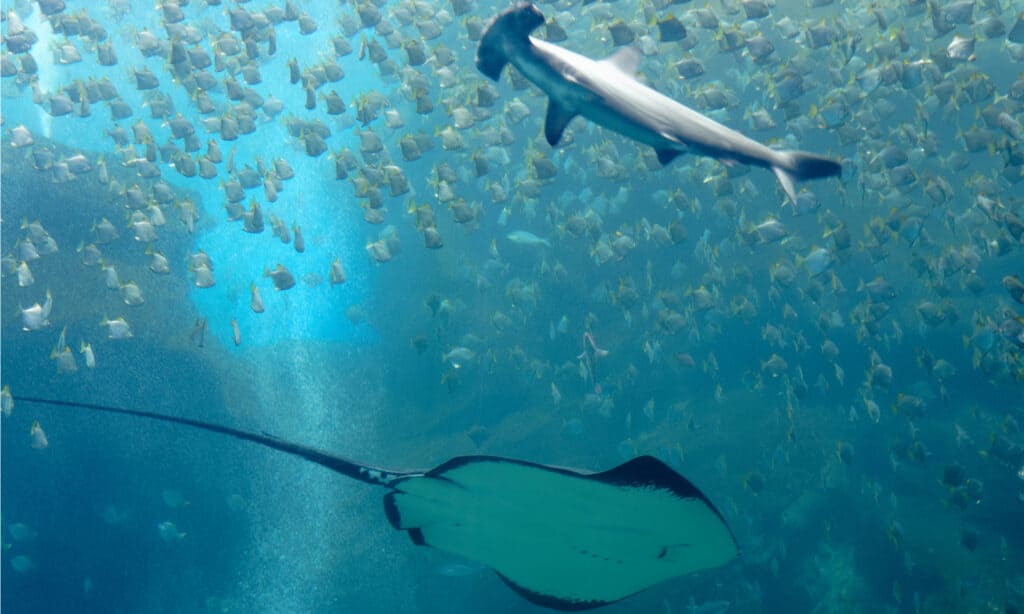
They may hunt with a
hammerhead shark
, but the shark is a predator of the ray.
©CHEN MIN CHUN/Shutterstock.com
There are 10 main types of stingrays:
- Ocellated river stingray
- Sixgill stingray
- Whiptail stingrays
- Potamotrygonida
- Yellow Stingray
- Round Stingray
- Butterfly ray
- Urotrygonidae
- Round stingrays
- Spiny butterfly ray
Classification and Scientific Name

Stingrays go by the scientific name
Myliobatoidei.©Vicki L. Miller/Shutterstock.com
Stingrays go by the scientific name Myliobatoidei.
They belong to the kingdom Animalia and phylum Chordata and come from the class Chondrichthyes and order Myliobatiformes. Stingray families vary by species, and there are 8 families with 36 genera. One of the most common families of a stingray is Dasyatidae.
“Myliobatoidei” is a combination of the word “Myliobatis” and the suffix “-idae.” Myliobatis comes from the Greek, a combination of a mill” (mylo) and “ray” (batis). The suffix -idae appears in the scientific name of zoological families.
Evolution and Origins
Studies suggest that freshwater stingrays originate from South America. As their name suggests, they live in fresh water in the Amazon.
This is in contrast to other types of cartilaginous fish. Most cartilaginous fish live in a saltwater environment. Additionally, freshwater stingrays eat crustaceans and other invertebrates.
Most scientists believe that the origin of the stingray is related to ancient marine incursions that happened during the Oligocene and Miocene periods.
Species
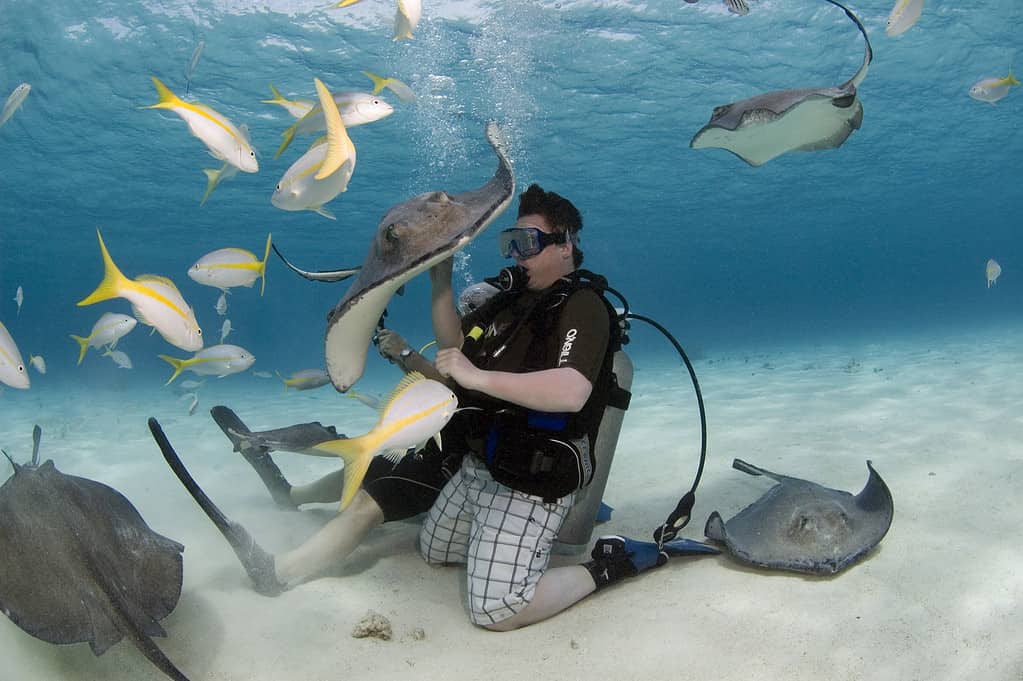
The Cayman Islands is home to Stingray City, where divers can swim with these majestic rays.
©Kfulgham84, CC BY-SA 3.0 – License
Stingrays include 10 different families of fish, and there are about 220 different species of these fish in oceans, freshwaters, and lakes around the world.
One of the most common freshwater stingrays is the river stingray, and the mother gives birth to live babies or pups.
In the Atlantic Ocean (as well as in the Mediterranean and Black Seas), the common stingray thrives, though only in habitats with depths of no more than 200 feet. They prefer to reside in muddy or sandy regions. In general, none of the species are aggressive unless threatened.
The blue-spotted stingray, however, will attack with their venom, which may be fatal if they sting the victim in the abdomen or heart.
If the sting occurs in other areas of the body, the outcome will not likely be fatal.
Appearance
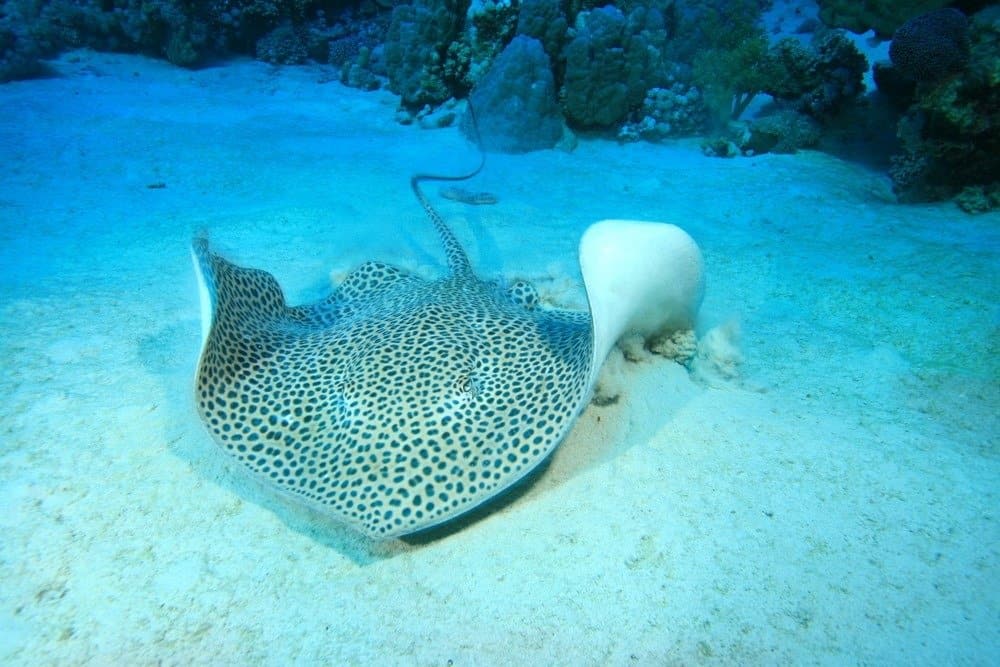
Darkspotted Stingray (Himantura uarnak)
©Rich Carey/Shutterstock.com
These fish have flat bodies only made of cartilage, which means that these fish lack any bones in their bodies.
They have broad fins that are the length of their full bodies. Despite being flat, the fins can often give the stingray a round look. Some of these fish look like they “fly” through the water, but the facts indicate that this is just a smooth flapping motion of the fins.
They also have defensive tails that usually help them to ward off predators when they sense danger.
Since there are so many species, color can vary drastically. Though the majority of these fish have a grey or dark brown back with a pale belly, they may also have spots with blue dots, yellow dots, brown dots, and other colors.
Distribution, Population, and Habitat

These fish exist in the Black and Mediterranean Seas.
©Natia Tsuleiskiri/Shutterstock.com
Stingrays live throughout the world.
The Black and Mediterranean Seas are primarily the home of the common stingray, the butterfly ray, the thorntail stingray, and the whiptail stingray. This area allows them to thrive in a calm area, often accompanied by sandy or muddy sea floors, as well as reefs.
Very few of them also exist in the northern Atlantic Ocean, southern Norway, and the Canary Islands, depending on the particular species. The deepwater stingray prefers the Indian and western Pacific Oceans, and some live in depths of over 2,400 feet.
The Bahamas have become so concentrated with these fish that they are a major tourist attraction in Great Stirrup Cay. There is also a stretch from the Western Baltic Sea to Madeira that makes a great home for these fish.
The overall population of the stingray is not known. However, there are enough of them in the world, as there are over 200 different species.
Diet: Predators and Prey
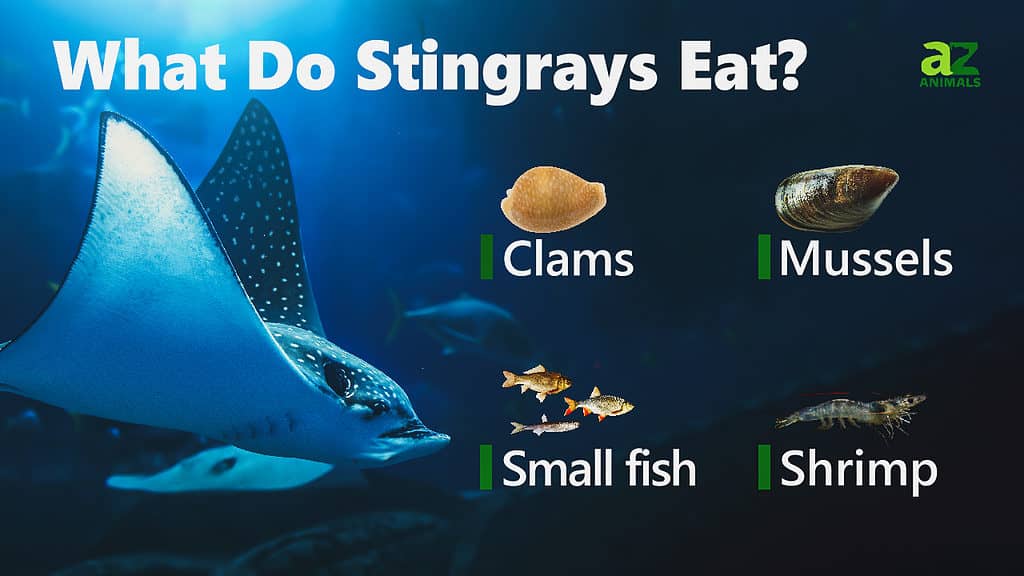
The main predators of these fish include sharks and seals. Other large fish also feed on them since the larger predators in the ocean will go after almost anything smaller than them.
However, their flat body and smooth movements allow them to lie against the floor of their natural habitat to hide. Rather than attacking when threatened, most will simply flee as quickly as they can. For the most part, the primary prey that they go after is fish that are smaller in size than them.
They usually eat clams, oysters, shrimp, and other small fish that are found in shallow waters, though they have been known to eat snails and squids.
For the most part, stingrays are not aggressive and are not very high up on the food chain. However, humans will fish for them to capture as a healthy source of protein.
Reproduction and Lifespan
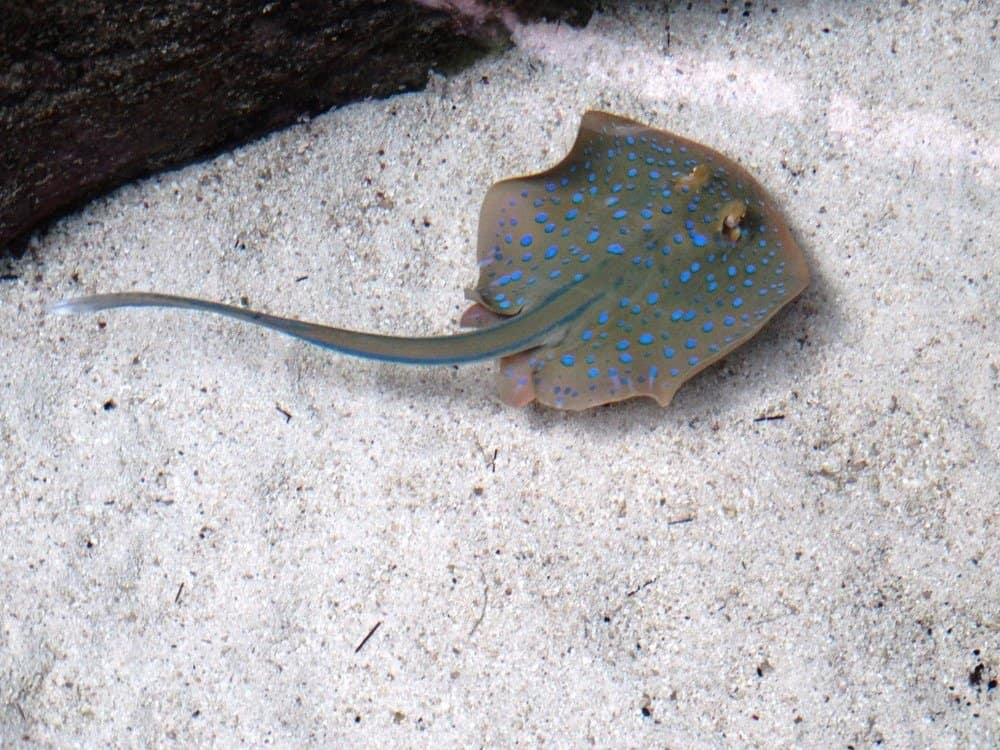
Babies are known as pups.
©Charles B. Cardell/Shutterstock.com
Stingrays reproduce using internal fertilization, which means that a male impregnates the female. This reproduction is preceded by courting, which the male does by biting at the female’s pectoral disc. Some stingrays have longer mating periods, taking over half a year before the female becomes pregnant.
The unborn babies are nourished and grow inside egg yolk inside the body of the female stingray fish. While the size of a litter of stingrays may vary, the birth typically brings 5-15 live young.
Since stingrays have survival instincts in their genes, the young do not stay with their parents after birth.
Stingrays live for around 15 to 25 years in the wild. In captivity, this lifespan can drop down to as little as five years in freshwater tanks with proper care.
Fishing and Cooking
These fish are caught using lines or spears and are safe to consume. They are eaten by humans across the globe.
The most common dish that is made and savored around the world is dried forms of the stingray’s wings. People have often said that they find the meat rubbery, and it tastes a lot like shark meat or scallops.
View all 293 animals that start with SStingray FAQs (Frequently Asked Questions)
Where are stingrays found?
Stingrays are found in oceans, freshwaters, and lakes all around the world and are known to exist in the Black and Mediterranean Seas.
What eats stingrays?
The most common predators of the stingray include sea lions, sharks, seals, and other large fish.
Are stingrays carnivores?
Yes, stingrays are purely carnivorous and eat fish that are smaller in size than them. They usually eat, snails, clams, and squids besides other small sea creatures.
How do stingrays sting?
Stingrays use the spines or barb in their tails to attack the predator. The defensive spines on the tails then insert venom into the other body.
Are stingrays dangerous?
While the venom that is inserted during the attack through the spine on the stingray’s tail can be very painful for humans, it is very unlikely that it kills humans.
Where do stingrays live?
Stingrays live throughout the world, including in the Black and Mediterranean Seas. Some species live in the Indian, Pacific, and Atlantic Oceans.
What Kingdom do Stingrays belong to?
Stingrays belong to the Kingdom Animalia.
What class do Stingrays belong to?
Stingrays belong to the class Chondrichthyes.
What phylum to Stingrays belong to?
Stingrays belong to the phylum Chordata.
What order do Stingrays belong to?
Stingrays belong to the order Myliobatiformes.
What type of covering do Stingrays have?
Stingrays are covered in Scales.
What are some distinguishing features of Stingrays?
Stingrays have flattened body shapes and venom filled tails.
How many babies do Stingrays have?
The average number of babies a Stingray has is 8.
What is an interesting fact about Stingrays?
A Stingray’s stinger is razor-sharp or serrated!
What is the lifespan of a Stingray?
Stingrays can live for 15 to 25 years.
How many species of Stingray are there?
There are 200 species of Stingray.
What is the biggest threat to the Stingray?
The biggest threats to the Stingray are sea lions, seals, sharks, and other large fish.
How many Stingrays are left in the world?
The population size of the Stingray is unknown.
How fast is a Stingray?
A Stingray can travel at speeds of up to 30 miles per hour.
How do Stingrays have babies?
Stingrays give birth to live young.
What is the difference between a skate fish and a stingray?
Even though both are cartilaginous fish, there are vital differences between a skate fish and a stingray. For a start, stingrays are dangerous while the other is relatively harmless. A skatefish tail is typically much thicker and shorter than a stingray’s tail. They also have different teeth and even reproduce and give birth in completely different ways. But that’s not all there is to learn about these fascinating fish.
Thank you for reading! Have some feedback for us? Contact the AZ Animals editorial team.
Sources
- Wikipedia, Available here: https://en.wikipedia.org/wiki/Stingray
- Live Science, Available here: https://www.livescience.com/what-are-stingrays.html
- California State University, Available here: https://www.csulb.edu/shark-lab/stingray-behavior-and-biology
- National Geographic Kids, Available here: https://www.natgeokids.com/au/discover/animals/sea-life/stingray-facts/
- Sea World, Available here: https://seaworld.com/orlando/blog/what-do-stingrays-eat/
- All About Stingrays, Available here: https://sites.google.com/site/stingrayfacts/home/stingray-video
- Smithsonian's National Zoo & Conservation Biology Institute, Available here: https://nationalzoo.si.edu/animals/freshwater-stingray
- National Geographic, Available here: https://www.nationalgeographic.com/animals/fish/group/stingrays/

